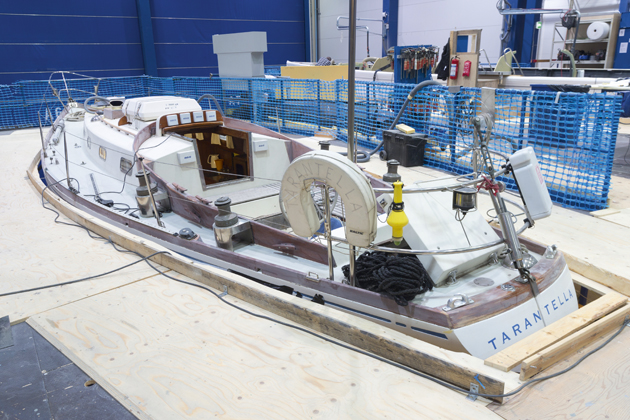Elaine Bunting reports from the ice-bound coast of Finland, where Nautor’s Swan build their famous range of luxurious Swan yachts, including the latest Swan 115
Immaculately tidy yard
Nautor’s facilities would be the envy of most yards around the world. They are enormous, modern and immaculately tidy. The work starts in a series of five huge halls outside the town of Kållby, where the plugs are carved out by a robot milling machine, moulds are made and hulls laminated and cured. The hulls of the pure cruising Swan 53 and 66 are still hand laid-up rather than vacuum-infused, but Swans of 66ft and above are in foam-cored carbon, or in some cases with a skin of carbon on the inside and another of glass on the outside – heavier, but easier to repair.
The attention to weightsaving here is extremely impressive. Every bulkhead is made with holes for wiring and plumbing conduits built in rather then being cut out later, and each is weighed before being taken into the hull and bonded in. This verifies that the material quantity is correct and allows teams to become more consistent in laminating.

The first glassfibre yacht ever built by Nautor, Swan 36 Tarantella, is being restored in the yard at Pietarsaari
The build material used in the carbon hulls is a mixture of pre-preg carbon and Sprint, depending on where it is to be used. The woven carbon of Sprint fabric sandwiches a toughened, hot melt epoxy resin. It makes a good bond with foam core, but not with honeycomb, so pre-preg is used on honeycomb-cored bulkheads and for components that require fine, sharp corners.
At one end of the laminating shed is a room Nautor calls ‘the lab’ where new materials and components are tested. A sign on the wall declares in Latin ‘non progredi est regredi’ – not to go forward is to go backwards. Imagine it as the engineer’s and physics teacher’s favourite room: there is a machine for testing the breaking strength and distortion of fittings such as backstays, a homemade climate cabinet constructed from a sunbed and a steamer where new varnishes are being tested. There is an experiment under way using connectors made with a 3D printer.
The teak hunter
Some kilometres away along snow-packed roads, near the town of Kronoby, is the joinery factory. Here 35 people, including 18 carpenters, make furniture for the yachts and, as at the laminating facility, what they produce is for Swans and only Swans. In most cases, the process begins with Pietri Wikström, a man they call ‘the teak hunter’ because he travels out to Burma to select the timber that will be used for veneers on the majority of Swans.
Nautor’s Swan is unusual in stitching the veneer skins onto the plywood itself (all the furniture is foam-cored). Many builders buy this ready-made. It’s a similar story with areas such as bunk corners and table trims. It would be cheaper and quicker to buy and fit ready-made inserts for the corners, but here they are all cold-moulded in situ to achieve the best possible timber colour match. It is an intricate process and the attention to reducing weight is highly impressive, and time-consuming. Making the major components of furniture for the new Swan 115, for example, takes between six and seven months.
The joiner work for each cabin is pre-assembled for checking, then taken apart so the wood can be given its surface treatment, such as gloss varnish or wax on oak, and finally attachments such as lockers and hinges are added before it is taken to the BTC facility at Pietarsaari where it is fitted into the hull.
Swans have always had a hallmark clean, minimal style, which has been updated and finessed since the purchase of the company in 1998 by an investment group led by Italian fashion group magnate and Swan owner Leonardo Ferragamo. It is telling that even at the top end of the range today, where custom fit-out is an unquestioned expectation, owners have gone for the quintessential Swan look.
That is, presumably, part of the attraction: if you are buying a Swan, you want it to look and behave just like one. Custom details requested can nevertheless be very intricate: one owner’s wife wanted white leather panelling on a master cabin bulkhead to be sewn with the same type of running stitch as her designer handbag.





